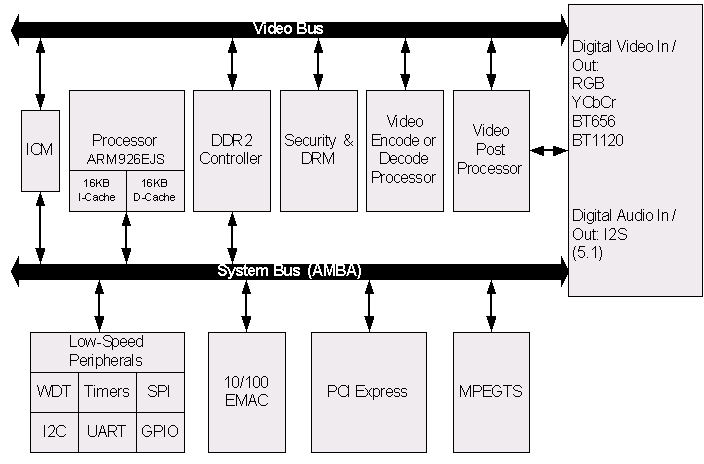This month fabless semiconductor start-up Quartics introduced the QV1721, a video coprocessor SoC targeting applications such as netbook PCs, set-top boxes and high-definition televisions. The QV1721 is intended to be used to offload demanding video tasks from the main CPU in a system. The chip provides high-definition video encoding, decoding, and transcoding functions, along with post-processing to improve perceived video quality.
Quartics recently demonstrated the QV1721 to BDTI in two products, a name-brand netbook PC and a high-definition large-screen television. In both cases, compressed video playback was smooth, and video quality was noticeably improved when QV1721 post-processing was enabled: images were brighter, sharper, and more detailed. Fully qualified QV1721 samples are available now, and are manufactured in a 130 nm process. According to Quartics, a process-shrunk version manufactured in a 65 nm process will be available in the first quarter of 2010. Quartics has implemented a wide range of popular video codecs, including MPEG-2, H.264 and VC-1. A top-level block diagram of the chip is shown in Figure 1.

Figure 1. QV1721 Top level block diagram. Figure courtesy of Quartics.
Quartics uses a programmable, application-specific, massively parallel architecture to deliver high video performance at low clock speeds. For example, Quartics claims that the chip can perform H.264 video encoding at 1080p resolution and 30 frames per second while running at a clock speed of 250 MHz.
This low clock speed, in turn, helps Quartics achieve low power consumption and low cost. According to Quartics, the QV1721 sells for under $20, and consumes about 3.75 watts when performing H.264 decoding at1080p resolution and 30 frames per second. Quartics says that the power consumption of the forthcoming 65 nm version will be about one-third lower.
Quartics uses a heterogeneous multicore architecture comprising several specialized data-parallel processing elements for decoding, with additional elements for post-processing. The processing elements are connected in a one-dimensional array, reflecting the data flow patterns of the target applications. Each processing element is coupled to a local VLIW control processor that serves to configure it for a particular task. The VLIW control processors, in turn, are controlled by an integrated RISC CPU. With this approach, Quartics is hoping to achieve the best of both worlds: the performance and efficiency traditionally associated with hard-wired solutions, and the flexibility associated with programmable processors.
Indeed, perhaps the most interesting aspect of the Quartics chip is its programmability. Currently, Quartics does not enable its customers to program the chip, but rather uses the programmability to achieve flexibility. For example, the QV1721 can perform 1080p 30 fps encoding, or two channels of 720p 30 fps encoding, or transcoding of one compressed 720p 30 fps stream. Similarly, Quartics supports a wide variety of post-processing operations, including deinterlacing, deblocking and sharpening, the details of which can be tuned for a particular display size and type. In the future, Quartics plans to use the programmability of its architecture to support new codecs and other video functionality, such as three-dimensional television.
Historically, programming complexity and tools have been a challenge for heterogeneous multicore processors. Quartics exposes the programmability of the chip only to experts within Quartics and a small group of partner companies, thereby avoiding—at least for the time being—the need to provide a refined tool set and other application development infrastructure to customers.
The Quartics chip arrives at an opportune moment. Consumer interest in high-quality video is growing—both in the traditional living room environment, and in other settings, such as a netbook PC, where energy-efficient video playback with enhanced video quality may prove to be a key differentiator. A key challenge for Quartics will be providing a complete product to multiple markets, including a highly integrated SoC with all of the necessary codecs and application-specific post-processing software—a massive undertaking for any company.


Add new comment